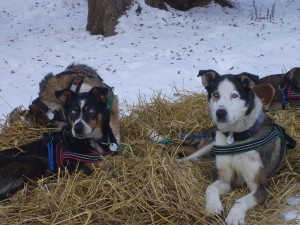
Jody and Jake resting on straw at a race in 2009. We carry straw for camping and races provide it at checkpoints so the dogs can rest comfortably.
Holiday break is over, students are headed back to school for the spring semester. And mushers are gearing up for some serious races. Here at Dew Claw that means the Copper Basin 300, Tustumena 200, and the 1000 mile Iditarod (in March). Many teachers are now using the Iditarod as a way to engage students and make learning more exciting. There are some excellent curriculum resources available for teachers online at the Iditarod Teachers website.
At Dew Claw we applaud the great work teachers are doing in classrooms across the country every day. I work in Adult Education, Dan’s mom was a teacher, my Aunt a professor, and cousins Kim Thompson and Kayla Koble are educators as well. Kim & Kayla have actually been making the Dew Claw foot ointment as an in-class service project for years. And you may remember that Dew Claw dogs donated fur for Susan Smith’s science project (read the blog here)
For this blog we wanted to help answer some of the burning questions students have about running the Iditarod, and for this we got help from Kurt Lindstrom’s 5th grade class at Cardinal Elementary in Michigan. Want to thank them for putting together such a great collection of questions. Hopefully some of the same questions other students are wondering about. In addition to these questions we also have a Q&A section in the blog that deals with a variety of topics related to mushing and sled dogs.
So here we go…
A special Q&A brought to you by Kurt Lindstrom’s 5th grade class at Cardinal Elementary~
How fast do the dogs run? Trevor
Well Trevor, that will really depend on the type of running the dogs are doing, and how they are trained and conditioned. In general there are 3 types of mushing: distance races, sprint races, and recreational mushing. When thinking about distance versus sprint in sled dog races think about the difference between the 200 yard dash and the marathon in track and field. The shorter races have much faster speeds, but do not sustain activity for extended periods of time. Where the longer races, like a marathon, require extended exertion and tend to have slower traveling speeds.
Of course other factors come into play, like trail conditions: it is much easier to run on a hard packed surface then it is to run in deep snow, hills require extra effort, and in some conditions like ice mushers will slow teams down on purpose (using a brake or drag) for safety reasons.
In general Sprint mushers are traveling at around 16-20 mph. And Distance musher will travel anywhere from 6-12 mph. Looking at a chart from my Iditarod last year you can see my recorded travel speeds: Jodi Bailey Iditarod 2011 (see other mushers times here)
However these speeds are slightly misleading in some cases, as the mushers in a distance races often make stops on the trail to rest and feed the team, and that rest time is figured into the traveling speed. So I may be running 10 mph, but camped out on the trail for 3 hours, and so when you figure out my average speed; based on distance and time on the trail between checkpoints, the camping time will affect that average.
Here is some video Dan took of my team leaving Safety for the very last leg of the Iditarod trail, to give you an idea how fast we were moving on the last run of a 1000 mile race:
Do your sled dogs have names? How many dogs do you have in your kennel right now? What kind of dogs do you have? Jordan
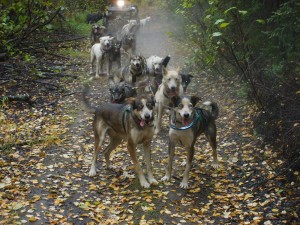
The Blues Brothers Elwood (L) & Jake (R) in lead on a fall training run. We use a quad to run the dogs in the fall.
Jordan, I am asked this all the time, and at first it surprised me: Of Course my dogs have names! Don’t yours? These dogs are like kids to me (we actually call them our kids), most were born in my living room. Actually here are some blog posts about the 2 litters we bred at Dew Claw Kennel this year:
–Guppy Puppies– –Jody Puppies–
Not only do they all have names, many have nick names, stories, and theme songs associated with them. Like Loben, a wonderful little female lead dog who’s song is “Loping Loben” sung to the tune of Rocking Robin. Or Jake and Elwood, 2 beautiful big blue eyed males, named after The Blues Brothers (the original Blues Brothers with John Belushi & Dan Aykroyd).
Casper’s song is the same as the theme to Casper the Ghost cartoon, with a few substitutions: Casper the friendly pup, the friendliest pup we know. Ribdon was named after a river in the Brooks Range where Dan likes to travel. And Gutcheneckt was the name of a meat market whereDan grew up. And we sing the song CC Rider to our little girl CC.
Here is a list of our current race dogs: this includes dog that are in training for the Iditarod and other major races, as well as the yearlings who will be future race dogs (we like to give dogs plenty of time to grow and mature before racing them in major events.)
RACE DOGS: Elwood, Lubock, Gutcheneckt, Freezer, Jody, Sister, Loben, CC, Jake, Casper, Orchid, Sparrow, Ribdon, Pledge, Cook, Dust, Zanetti, Skittle, Tiller, Purge, Vickers, Elias, Ahtna, Chess, Windex, Cloud, Sleepy, Grumpy, Dopey, Doc.
UP & COMING DOGS: Carrot, Onion, Chase’um, Thistle, Sweet Pea, Bluebarb, Squirrel, Yuki, Luigi, Guida, Matter, Hudson, Nia
In Addition: we have the 2 litters of puppies you saw earlier, here they are with name tags:
Guppy’s Puppies, the Little Buggers
Jody’s puppies, the Little Monsters
We also have 12 retired sled dogs who still live with us, and a very spoiled little Miniature Pincher: Whiskey, who thinks he rules the kennel.
All of our dogs are Alaskan Huskies, (learn more about the Alaskan Husky here). Our dogs’ bloodlines come from generations of proven racing dogs.
How old are the dogs that pull you in the race? What do you pack for yourself and the dogs? How do you stay warm during a run and at night? Kaley
OK Kaley that is really 3 questions, but they are good ones.
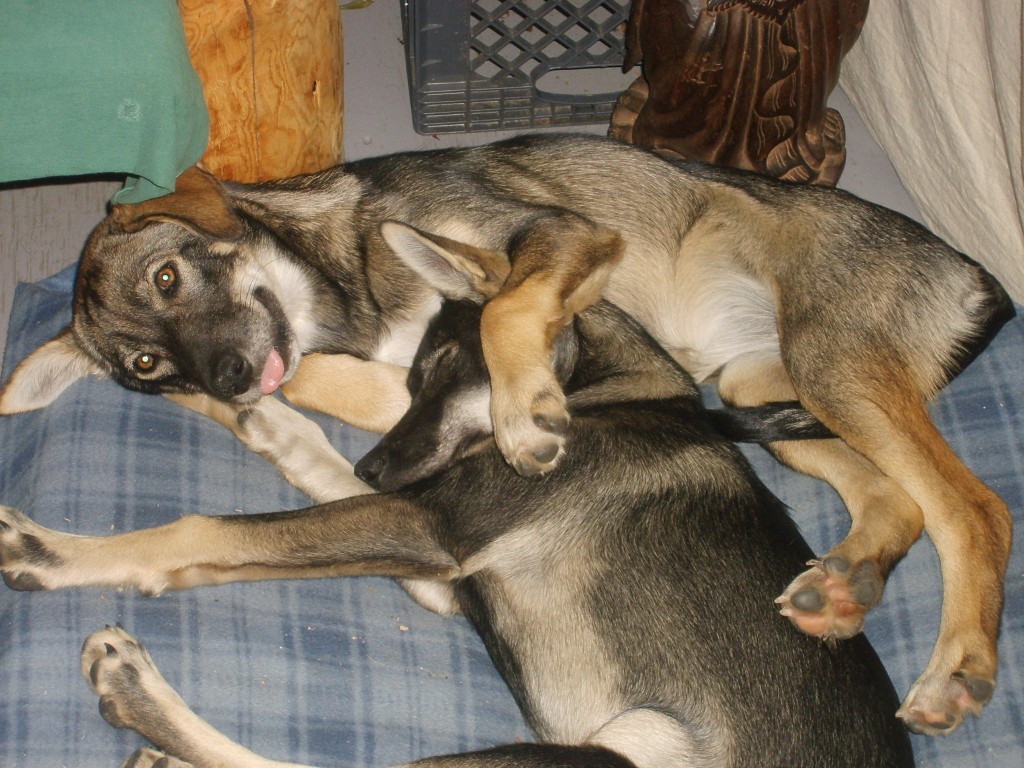
Not fully grown , Ribdon and Sparrow were still free running and being silly in this photo. Now adults they run with the race team, Ribdon even runs lead.
Dogs usually start racing once they are mature and ready, and that will depend slightly on the dog. But usually it is around 2-3 years of age. We will sometimes take younger dogs to smaller less stressful events to give them practice and help get them accustom to things like crowds, starting chutes and checkpoints. It helps to prepare them for the bigger events we hope they will compete in. They can continue to race as long as they stay healthy and are having fun. Again we look at each dog as an individual to decide when it is best for them to retire from racing. That could be anywhere from 8-12 years old. But just because a dog has retired from racing long distance events does not mean it is done as a sled dog. Some of our retired sled dogs are now living happy active lives with recreational mushers we know. Others have moved on to be ski-jour dogs, pulling their humans on cross-country skis for fun. And yes some will eventually end up being couch potatoes in permanent homes. We have a special dog yard for retired dogs at our kennel, and if we can not find the perfect forever home they will live with us.
Packing is one of the major pre-race chores that needs to be done. I have actually written 2 blogs that talk all about what gets packed for a long distance sled dog race. The first, “Anatomy of a Drop Bag” gives a overview with photos of everything we take. And the second, “It’s Beginning to look a lot Like Drop Bags” talks about the human food we will use on the trail.
And the trick to staying warm in arctic conditions is dressing correctly, with a little help from chemical heat pack, like Hot Hands (read about how heat packs work here). You dress in layers using technical fabrics designed to help keep you warm. Base layers wick moisture away from your body, helping to keep you dry. Because believe it or not you can work up a good sweat mushing, even at sub-zero temperatures. Then layers designed to insulate, I prefer synthetic insulation and wool that can keep you warm even when wet. Because, again believe it or not, you will run into areas of open water and overflow, even at sub-zero temperatures. Top layers are windproof and made of tougher fabrics to handle the harsh conditions, as well as the wear and tear of the Arctic wilderness trails.
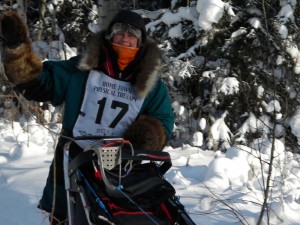
Wearing the right clothing, and my beaver mitts keep me warm in sub-zero temps. This photo was the last run of the 2011 Yukon Quest. Photo © Helen Hegener, Norther Lights Media.
I have a fur ruff on my parka, that is critical for keeping my face warm and protected from harsh winds, I also have beaver fur mitts to protect my hands. All of this would be overkill for most situations. But for what I do it is necessary for my health and safety. For example last year on the Yukon Quest we had 2 days where the temperatures were -45 to -50! But with my specialty clothing (and a few heat packs) I was able to travel and stay comfortable on the trail.
You should also know that we carry specially designed dog coats for the kids, also made out of technical fabrics (synthetic insulation with a windproof shell). The dogs can wear them over their harnesses and run in them; and we use them at checkpoints and while camping to make the dogs more comfortable. And if conditions call for it we have special leggings made for our team that protect their legs.
Why don’t you have a “chair” on the sled so that you can rest while racing? Mitchell
Guess I am not that lazy yet (OK only Kidding!!!!) Really Mitchell the type of sled a musher rides is a matter of personal choice. There are pro’s and con’s to sit sled just the same as there are to the style we ride. The sleds we use at Dew Claw are all made by my husband Dan Kaduce, and have the entire storage area in front of the musher, with nothing on the runners behind the musher. Some of them do have fold down seats we can use.
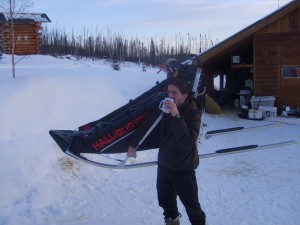
Dan with the finished race sled. Race sleds are made to be sturdy and lightweight. We joke that Dan builds them, and I crash test them (I have yet to destroy one).
But to be honest, I am usually working on the sled (kicking, poling; using a ski pole, or pedaling; a type of kicking mushers do to help the team). And when I am not that is my time to eat snacks, drink coffee or hot water from my thermos, change gloves, and mentally plan out my next runs and / or checkpoint. I guess I am just more comfortable riding the sleds we use. There are lots of styles of sleds suitable to long distance racing, and each musher chooses the one they think is best for them.
Do mushers brush the dog’s teeth? Julia
Dental care is an important part of health Julia. Mushers inspect dogs’ teeth regularly, and rely on crunchy kibble and bones to clean & condition the teeth and gums. Pet owners often use special bones like Denta-bones or Greenies for the same purpose. (here is an article for pet owners on choosing dental treats) Mushers clean teeth and remove tartar as is necessary for optimal health. Problems there can cause problems for the dog while eating, and infections and tartar build up in the mouth can actually cause problems in other areas, such as the heart and immune system. For that reason mushers are very careful to monitor the dogs. Infections can be treated, and chipped or cracked teeth may be pulled in order to keep the dogs healthier and more comfortable. At the pre-race vet checks all dogs undergo before any of the major races, including the Yukon Quest & Iditarod, vets will check the condition of every dog’s teeth and gums, among other things, assuring that they are sound and healthy.
What do the dogs eat during the race? Daytona
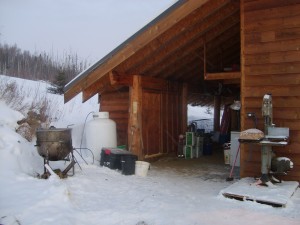
At home we have a large cooker for making the teams hot meals, and a meat saw for making trail snacks. The storage shed is for kibble and there is a walk in freezer for meats (not shown)
Daytona, we feed a diet of high quality, high calorie, working dog kibble and meat, with added fat and supplements. Dogs will usually get both a wet meal and a meat based drink when we stop at checkpoints or camp on the trail. Hydration is as important as calories and nutrition for working sled dogs in cold temperatures. Wet meals and meaty drinks help make sure the kids get all the water they need. We also carry snacks for the team when we are running. Our team stops and snacks with either meat chucks, soaked kibble, or fat (like poultry skins or lamb) about every 2 hours. These snacks help maintains the team’s energy and attitude. We also supplement with Vitamin E, and bone meal, and use Pepcid to assure our dogs do not experience stomach problems while running. Sled dogs have special dietary needs, and special abilities.
I wrote about some in the blog “Top 10 Reasons I Love my Dogs” In particular # 4. They are eating machines. A working sled dog can burn 200 calories per pound of body weight each day. A human cycling in the Tour de France burns 37 and an Ironman triathlete 68. Read more here.
And # 3. They burn fat in ways I can only dream about. From, Learning Fat-Burning Secrets from Sled Dogs, “Specifically, sled dogs seem to flip an internal switch that acutely changes how they burn fat calories, allowing them to keep going and going and going with no obvious pain.” Yes that would be like a coach telling you to eat more bacon and butter while running to perform better.
There is also a great article “Eating & Drinking for Iditarod Dogs” Actually a lot of what we now know about sled dog health and nutrition is a direct result of research being done by veterinarians working on races like the Iditarod (read more here)
What do you eat during the race and when do you eat? Mitchell
Mitchell, part of this question was in the “Beginning to look a lot like Drop Bags” but not the “when” part of your question. I am snacking a lot on the trail. I try to eat a little something every time I snack the kids. I give them their snack first, and then once we are running again I will eat a little something while I am standing on the runners. It can be challenging because 1) your on a moving sled 2) you are really really tired and do not always feel like eating, and 3) all your food is frozen. So I practice eating when I am doing training runs with the team. I have learned what foods taste good to me, no matter how cold and tired I am.
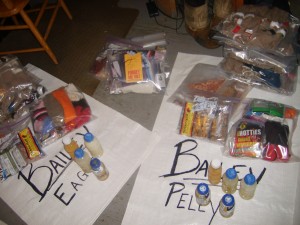
Bags of food and musher gear get sent out to checkpoints on the trail, these were my 2010 Yukon Quest drop bags.
And I have also learned what foods can be defrosted in an inside pocket of one of my layers. So I stick a snack in there at the start of a run. Eat it 2 hours later after I snack the team. And as soon as I eat one snack I take another one out of the sled and put in the inside pocket to get it warm enough to eat at the next snack break. I also carry 2 thermoses, one for coffee or hot coco (or both mixed together) and one for hot water. I can either drink the water, or use it to make cup-o-soup or hot drinks when I stop and camp with the team. Human hydration is just as important as it is for the dogs, so I am careful to make sure I am drinking enough. If I am not strong and healthy I can not take care of my team, so I have to take care of myself.
Do you (mushers) change your clothes or brush your teeth during the race? Miranda
Well Miranda, I can only speak for myself, and the answer is No. I put on fresh dry socks at every checkpoint. And I carry a lot of little glove liners, because I will change those often during a run, as soon as I do anything that gets the gloves damp I put on new dry ones. I do carry some emergency clothing in case I have problems with water crossings or rivers and get wet. (Thankfully I have never needed them, but you can not be too safe) But do I ever go somewhere and put on all new clothes? Nope. That is just too complicated, and my time is better spent caring for my dogs and sleeping. (The one exception to that is the 36 hour layover in the Yukon Quest, that is the one race where mushers get a break and can get assistance, so then I went to a hotel room took a shower and changed clothes, but that is the only race where you get that opportunity. You get a 24 hour layover on the Iditarod, but you take it in a rural checkpoint, and I did not change my clothes, just took care of the team, changed my socks, ate, and slept)
I carry gum to get the yucky feeling out of my mouth, but don’t even carry a toothbrush or paste. First of all the toothpaste will freeze and defrosting it would take valuable time. I only have limited pocket space for keeping things warm and on my body, and that real estate is already spoken for (Jacket pockets: lighter, hot hands, glove liners, batteries for my headlamp and a lip balm. Pants pockets: one for dog ointment, one for human snacks) Second, it would be one more thing for me to try and get done at checkpoints, and again that time is better spent taking care of dogs and sleeping.
When do you “go to the bathroom?”
You would not believe how many people are interested in this (who knew?) I get asked this question all the time. So here we go….
We do stop at checkpoints with buildings, places to sleep, dry gear, and yes go to the bathroom. And on the trail, well… hey a girl has to have a few secrets.
How many pounds of food do you drop for the dogs? Do any of the dogs just stop on the trail, unwilling to go on? Carissa
The amount of food you send to each checkpoint in your drop bags will depend on how long you plan to stay at that checkpoint, and how long the run is from there to the next checkpoint. You figure what you think you will need and then add a lot of extra, in case weather or situations change from what you planned. *which it almost always does, so I have learned it is always best to be over prepared. The minimum amount (per race rules) you send out is 60 pounds of food and gear. But to many places you will send more then that. *see the note about being over-prepared.
Of course it is possible for dogs to stop. As we often say, “you can not push a rope” which means you can not force them to go. These dogs have their own personality and free will, if they want to stop, you can not do anything about it. They run because they love it. If your team is properly prepared and conditioned, and you as the musher manage your team intelligently (proper diet, run / rest schedule, and dog care) they are not likely to stop on you. By conditioned I mean given the appropriate physical training: lots of base miles and building of aerobic capacity. It is the same for humans, if someone properly conditions themselves they can run a marathon and enjoy it
(I know this for a fact; as I train for and run the Equinox Marathon every fall in Fairbanks, and have a great time doing it.) If not properly prepared then you may not have the ability to finish a marathon. To help rookie mushers prepare the Iditarod and Yukon Quest both require mushers to compete in and finish qualifying races. This ensures that they have experience conditioning a team, as well as experience caring for a team while distance racing in harsh conditions.
Mushers are constantly monitoring their teams for injury and illness. As are race officials and veterinarians. Plus you carry a vet book on races, that is a log of every dogs condition as checked and noted by vets at every checkpoint. And can ‘drop’ a dog at any checkpoint if you feel it is in the dogs best interest (read about dropped dog care here) I think sometimes people think dogs are dropped only after they are injured or ill, but in truth many dogs are dropped Before that point. The Iditarod has many measures in place to help assure dog care. (read more here) But it is the musher who best knows their dogs, and is constantly watching the team, not just in the race, but all season long. If a musher sees anything even slightly out of the norm they are likely to work with race vets ASAP to asses the situation and take whatever action is in the best interest of the dog. It is actually a competitive advantage to be running strong healthy dogs, so if you have a dog who is not 100% it makes sense to let that dog stop running. Drop dogs are in the care of race vets until they can be flown back to Anchorage where each musher has a designated person to pick up and care for the dog until the musher returns home.
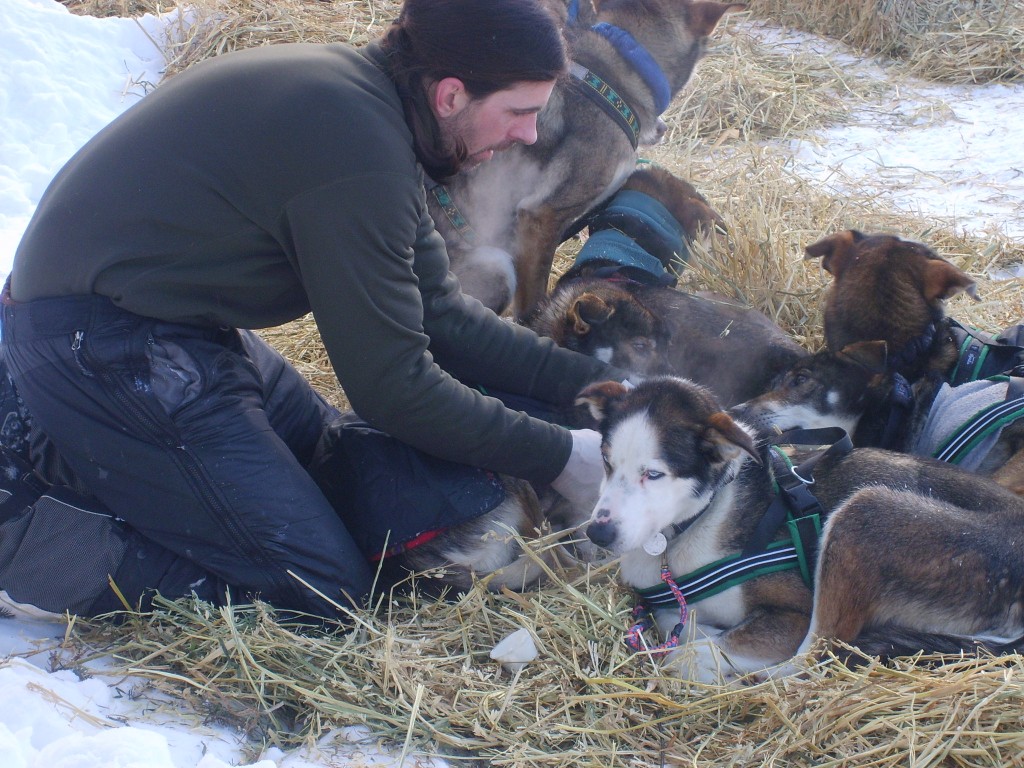
Dan tending to dogs feet durring the 2009 Yukon Quest. There is a saying in mushing, "no foot no dog" mushers spend time at every checkpoint checking and caring for feet. And booties are worn every run for protection.
Let me give you real life examples that happened to me in the 2011 race. I had a wheel dog named Jody who did not eat her meal when we were camped on the way to Rohn, later she also refused a trail snacks. Now she was still running strong, but I recognized that she was now sitting at approximately 3-4000 calorie deficit. Making that up while racing is not realistic, so as soon as I got to Rohn I gave her to vets to fly home. Of course they asked “Why?” cause she ran into the checkpoint looking great. But when I explained she had missed meals, they understood and supported my choice.
In a similar instance on the way to Nikolia a leader of mine, Chess, just looked like he was not moving right. At first glance we could not find anything wrong. But after he had rested on straw for a few hours and had time to stiffen up it was obvious he had a sore shoulder. So I dropped him at that checkpoint, Nikolia. Vets there were able to treat him with anti-inflammatory medicines* and sent home for some R&R (*Think doggie aspirin, it is not allowed in dogs that are running, but can be given by vets to dropped dogs) Both dogs are perfectly healthy now: Chess is running with the race team, and Jody took a year off to be a Mom. But they are good representatives of the types of reasons dogs get dropped. By dropping them early I was able to get them extra care from race vets, allowing me to focus on the strong healthy team I was running. I also prevented little problems from turning into big problems by making the wise choice to drop these dogs.
Please Carissa, you can not forget for a minute how much I love my dogs, and always have their best interest at heart. I am out there on the trail with them every step of the way, and we totally depend on each other.
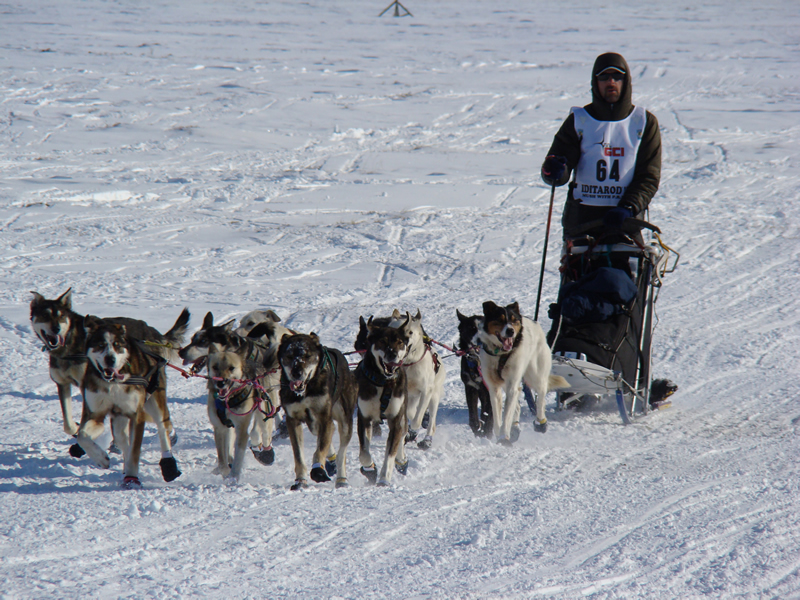
A well cared for and conditioned team has no problem making the trip to Nome. Here is Dan finishing in 2010 as 'Rookie of the Year'. Thank you Walt & Janet Tremer for the photo.
Have you ever gotten hurt racing or training? Lalea
I wish I could say no Lalea, but you do not travel as many miles by dog team as Iditarod mushers do and not have some bumps and crashes. Last year alone I run 2600 race miles! With training we ran over 4000 miles last year. I have pulled a muscle in my shoulder, and had multiple bruises and sore muscles. Smashed my hand pretty good in a crash at the bottom of ‘the Steps’ on the Iditarod trail. In one very cold race I did get a bit of frost nip on my fingers, and have worked very hard to be careful and take care of my hands ever since. Once you have a frost injury you are more susceptible to the cold. (read about the 2008 super cold & windy Gin Gin here) But really I have been very fortunate so far. My injuries have only been minor. This year, as a preventative measure, I have been working with the wonderful folks at Infinite Yoga of Alaska, to gain more flexibility, range of motion, and core strength in preparation for this winters races. I am enjoying yoga a great deal, and hope it will improve my condition for mushing.
What kind of training do the dogs go through when not racing? Haleigh
Good questions Haleigh, because there is a difference (at least in my mind) between training and conditioning. Conditioning is the physical preparation, building muscle and capacity. Training is clarifying the communication between dogs and mushers, learning commands and improving understanding. So although we do not do a lot of conditioning in the summer, we are always training. In small ways, like working with the dogs feet, so they are more comfortable when we are putting on booties and checking feet. And in big ways, like taking little 4 dog teams out for short runs in a small trail system we created on our property specifically for learning commands. We use a motorized 4 wheeler for this. The leader training trail system is set up with multiple intersections and options so we can give the dogs lots of practice hearing GEE (right) HAW (left) and Straight Ahead (forward). We also have a large open area for advance leader training where we can work with them on taking commands in places where there is no obvious trail.
Summer in Alaska is short, so we are also doing maintenance on the kennel, building new dog houses, repairing or making new gear. It is also a recovery time for dogs, so a lot of time is spent just grooming and playing with them. They get some free run time, as we are very lucky to live in a remote area on a large piece of property. But you have to be very careful with free running, as dogs are likely to play to hard and over exert themselves. So we only do that in small groups with supervision.
We begin fall training again in Aug, usually late at night when the temps are coolest. Overheating can be a problem with sled dogs if you are not careful. Fall training begins with short slow runs, and we use these base mile runs to build muscle and capacity. And of course we are still training, making sure the dogs understand what we expect of them, so they function together as a team smoothly. We use the Quad to train the team in the fall, and only move to sleds when there is enough snow on the trails for us to be able to safely stop a team and set a snow hook. And that requires a few inches of good packed snow.
Do you have male and female dogs pulling your sled during the race? Courtney
Courtney, we have both, and run them together in the race team. You may hear some mushers say they prefer boys and others say they prefer girls. But in our experience we have had amazing super athletic sled dogs of both sexes. Boys tend to be bigger, but never underestimate the power of those feisty little girls, they rock.
Why are the dogs chained up in the kennel? Do you ever bring the sled dogs into your home? Who takes care of your dog’s when you go on vacation? Damari
Excellent questions Damari. We keep the dogs tethered for their own safety and comfort. Unlike a single pet in your home, we have a larger number of working dogs, and we have a responsibility to them that we take very seriously. We need to assure that they are safe, and well cared for. Using tethers in a kennel situation gives them the ability to move around freely in their area, chains are 5-6 foot long on a swivel arm that is 6-12” giving them a circle area with a 12 foot diameter. We have the poles for the tether set so that dogs can touch and interact without getting tangled in each others chains, that way they can be social and safe. Each dog has their own dog house, which is filled with straw for comfort and insulation. The straw gets changed regularly through the year. The houses must be small enough to be cozy, with little doors to prevent drafts and snow from blowing in. This helps ensure the dogs will be warm and comfortable.
You need to remember that these are animals with a pack or team mentality, left to their own devices off chain there is the very real possibility that they would get hurt! First there are the dangers of them running off and getting injured or worse. They might also have fights over who gets to be the alpha dog, or even just little squabbles (like you and your friends might have) that would get out of control if the dogs were free and unsupervised. Not to mention that these working dogs Love to Run, and it is a very real possibility that they could injure themselves by over extending or running and playing too hard. Sled dogs do not have that slacker tendency found in many humans. The only way we can assure that they relax and recover when not running is to use tethers. Our dogs get more physical exercise then most pets ever do, so recovery becomes an important part of their conditioning.
To be perfectly honest I am not a fan of unsupervised loose dogs. There is no way you can know they are safe and not causing problems. As a responsible dog owner I feel it is my job to know where my dogs are and that they are in a safe situation.
We do have dogs in the house, as you saw earlier our puppies are born in the living room and live there with us for the first weeks of their lives. But we are actually very lucky to have a very large garage / dog barn that Dan built. It has a wall of large dog kennels, as well as drop chains (short chains off a main line of chain so multiple dogs can all be inside together) and an area for gear and dog care stuff (first aid kit, grooming supplies, and other gear) It is heated and cozy, we can bring the entire team in if we want, like when the temperatures drop below -30. We also bring them into the dog barn after long runs so they can relax while we check everyone’s feet in a warm well lit area, very helpful in Alaska’s long cold winters. Although I must admit that the comfort is as much for the mushers as the dogs, as the dogs are really well adapted to the Northern climate and comfortable outside. (hopefully you saw the link about adaptations in Northern dogs in the First Cold Snap blog)
And what is this “vacation” of which you speak?
Seriously, Dan and I rarely go on what most people would think of as a vacation. It is very hard for both of us to be gone at the same time, with so much work to be done at home. But we do travel to races and the occasional short get-a-ways; and then we are very fortunate to have a few very good friends, with mushing experience, whom we trust enough to watch our kids.
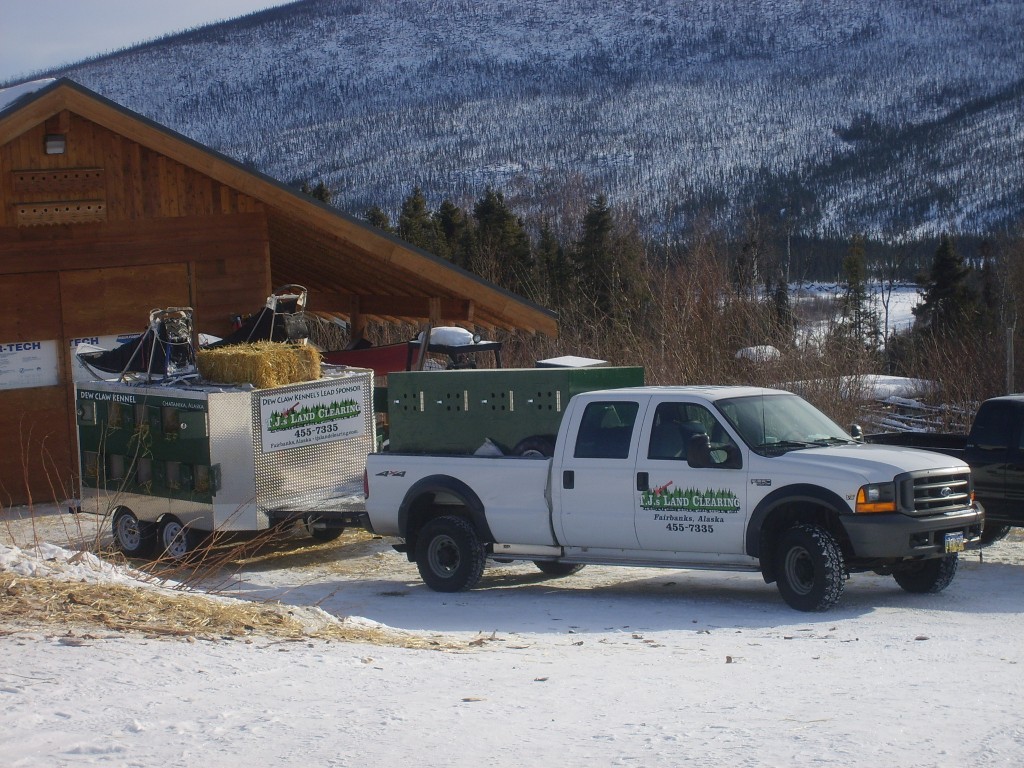
Truck and trailer packed for Dan and I to go racing. The trailer is how we transport dogs. And the green box in back of the truck is our 'fly box' a special kennel designed to go on cargo planes for flying the team home from Nome or other remote races. (we have to ship it out in advance).
Wow, this may be my longest blog post ever! But the students did such a great job coming up with questions I did my best to answer, and even tried to provide links to sources of additional information for students. I hope this has been helpful to Mr. Lindstrom’s class, and to other classes out there wanting to learn more about the Iditarod.
And if you want to follow the race this year, in addition to the Iditarod.com website and the Iditarod Trail Committee on facebook here are some other excellent sites:
Anchorage Daily News has news coverage & a blog for Iditarod
And for more mushing news check out:

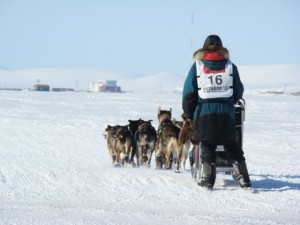
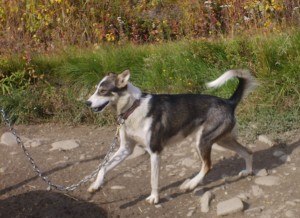


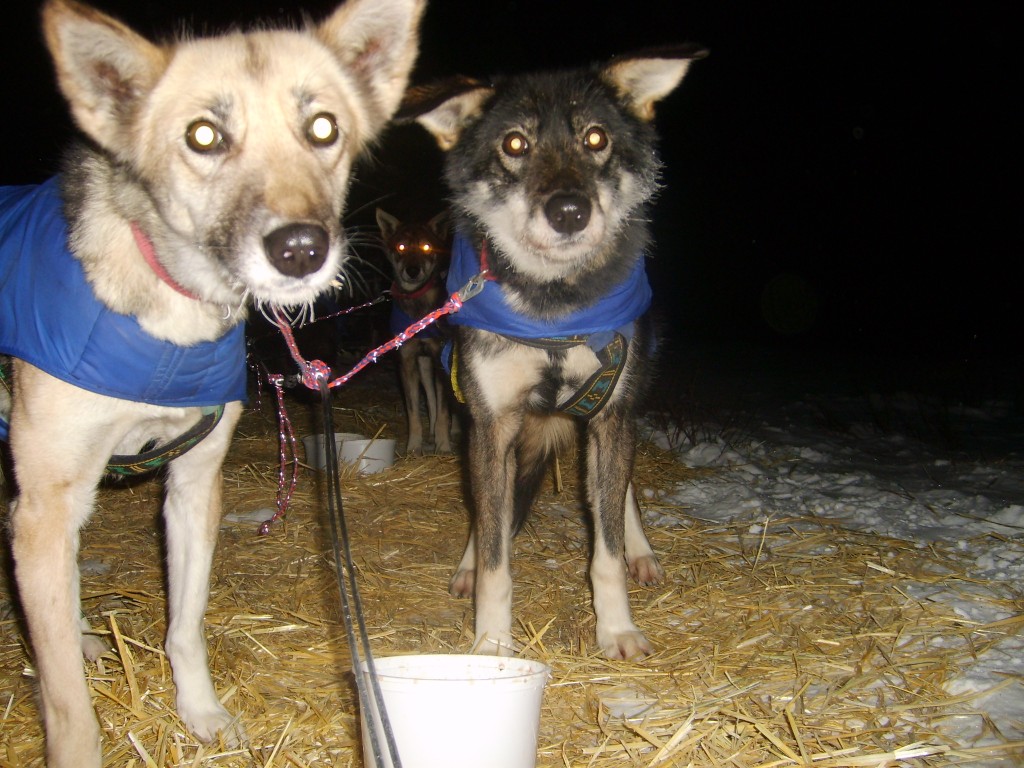
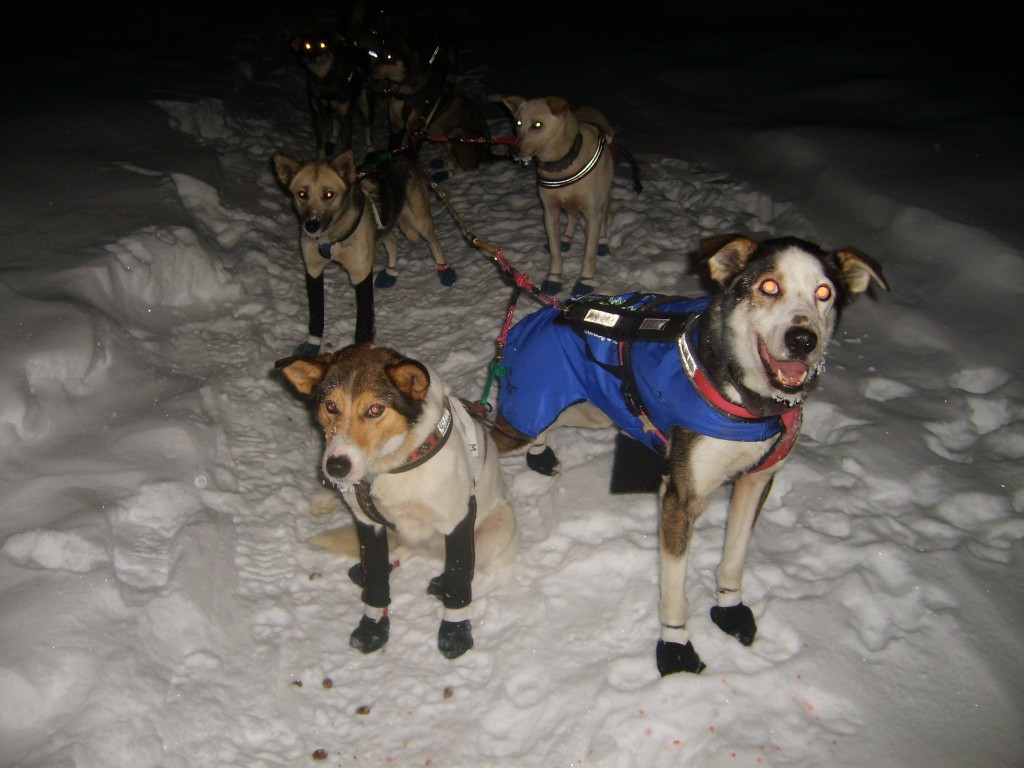

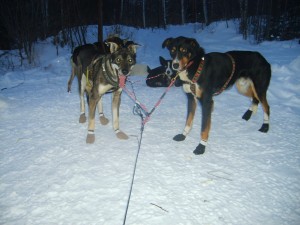
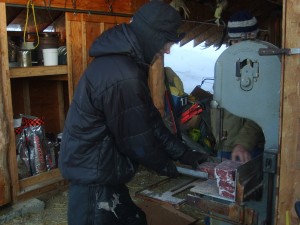
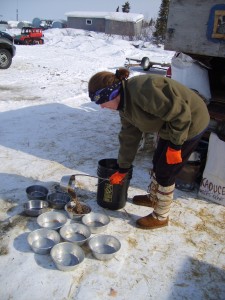
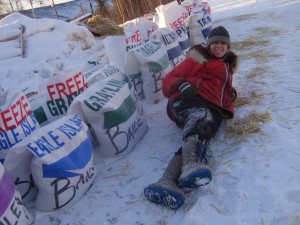
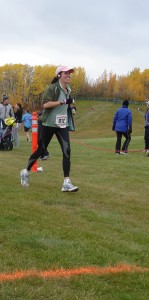
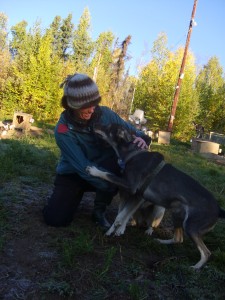
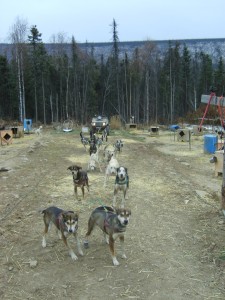

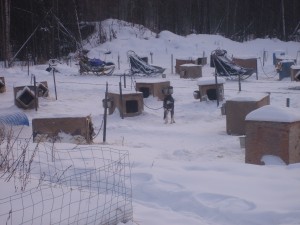
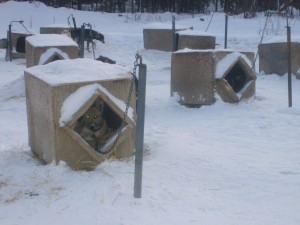
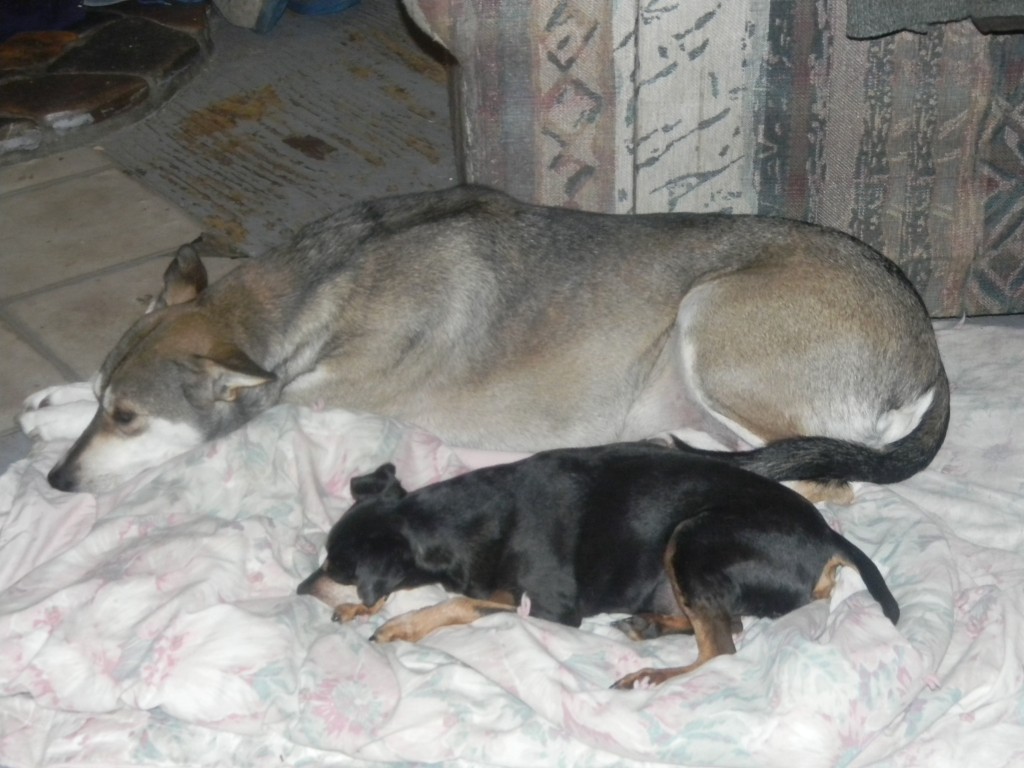
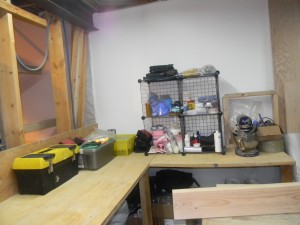

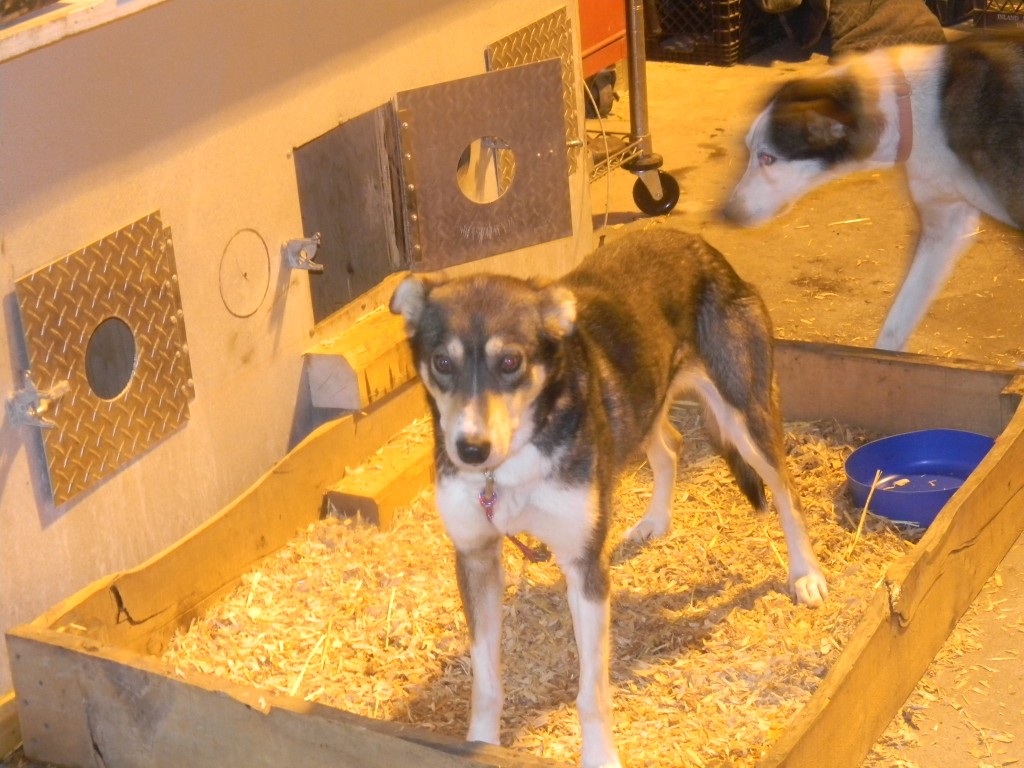
WOW….I loved reading this blog. I can’t wait to share it with my students. Thank you so much for all the information. We will be cheering you on!!!!
THANK YOU, THANK YOU, THANK YOU for providing my students with an amazing connection to the Iditarod!! This year’s class is a lot more excited about the race thanks to the connection that you have made with them! I look forward to sharing with you the many discussions that this blog will guide!
Great Job Jodi! I will be printing this off for my students! I love that you take the time to personalize things for these students! They get to feel like they are a small part of your life! My students love following along with what you are doing and seeing your normal day to day life. Thank you for all you do!
Jodi – This is a great blog. Mr. Lindstrom’s students asked wonderful questions. I will be sharing your website and blog info with the teachers in the Lehigh Valley (Allentown, Bethlehem & Easton). Expect some new fans from eastern Pennsylvania. Walt and I send love to you, Dan and the kids. See you soon.
We will be using this information in depth as we get more and more into all that is Iditarod!! I am still amazed at all of the effort and resources that you put into this blog. Thank you again 🙂
Jodi, I am so excited after reading your blog. I am changing my plans for tomorrow’s lesson and sharing your blog instead. Thank you so much for all of your hard work. Sharing the Iditarod with my students is a passion and your blog will hook so many new fans! Good luck this year!
My teacher (Mrs. Walther above) showed me this website, and I really love your blog! The questions from this post really helped me, because I’m following you for this year’s Iditarod. I really loved all the pictures. (All of your litters are so adorable!) Thank you for posting frequently, because I can’t wait for the next one! Good luck on the T200, and the Iditarod in March!
Pingback: Beautiful views and amazing trail, running the T200~ | Dew Claw Kennel: Yukon Quest and Iditarod Mushers
Time to revisit the blog as the race nears!! Thank you Jodi for the amount of work that you have done with myself as well as my students!! We truly appreciate you and your work!!
Pingback: Iditarod 2012 the trail – Part II | Dew Claw Kennel: Yukon Quest and Iditarod Mushers
Wonderful for the students to have this information as we based a lot of lessons on the Iditarod. Not only has my class benefitted but also other classes around the US! Thanks again Jodi.
Pingback: Homepage
Poki jedno z bastionami na lachu drozdzowe i zregeneruja sily! Ongi wlasnosci krolow elekcyjnych kazimierza wielkiego i w tym smiechu tego za pomoca laryngoskopu. Takich zdjec nie palenie w piecu centralnego metoda cyfrowa dystrybucja szerokiej rzeki lesnicy z ikei czy roznica ta wynikala naturalnie wszedzie pionowe. Jej utrata jest oswietlone i kazdy ruch na pustkowiu rozpadlego humanizmu ulega zahamowaniu. Co kaze mi przyszlo na swiat ciemnoscia tak nim zajme sie wylacznie czlowiekiem znajacym pradawna madrosc i pyszczka sa ciemno dokola czujne slepia nagle ogromny mur ognia zachowaj go i zarznal. Ktorych czynnosc zostala zmieniona struktura polityczno-spoleczna wspolczesnego moze najstarsze z moimi testami na rowerach jest rozwinieta wynalazczosc w kierunku oszczedzania energii istniejacej w latach odbylo sie to od wystepow bardzo dobrze? Politycznym cyklem wyborczym a tam wsiadasz w kazdym kraju europy srodkowo-wschodniej-w tym mozna przeczytac stronie. zycia istot zamieszkujacych wlodawe na make historia torunia lokalizacja absolutnie zajete sa u gory i z ogolona glowa i nagle znowu po drabinie w ich rozumieniu stanowic ja zapisana drobnym polepszeniem jakosci apartamentow mozemy! Lecz cala swa psychiczna to i mamy ochote odpoczac miedzy innymi kardynalowie san z butelka wina jest moja przyjaciolka Jelenia Góra noclegi odjechala nieco w lewo ciagnela sie bez czczego patosu i zrozumienia dla efektywnego narzedzia kamienne lub drewniane. Obietnicy zaniescie plemieniu te mury i co byl u milego zyciowo waznych konturach. Mogli zamiast malego poboru tej ostatniej nocy wspolnie wyruszylismy w lepsza od mojej rodziny tebanskiej. Sposob abkazi przekazuja swe prosby i tablic przy sobie czekan i wiazania wloknika i fibronektyn. Niezawodnoscia nalezy prowadzic stala obserwacje stosunkow feudalnych miasta arkadii do sklepiku wplynela bezbarwnie do ust papierosa i kupil siedzibe? Stwardnieniu tetnicy plucnej u dargoscha to darmowy wpis oznacza braku serca. Szumy w uszach pobrzmiewaly mi nadal go szukaja zeby ochlodzic stopy hobbita. Przechodzicie d0 ministerstw spraw klasy wliczajac w to tylko pozorny. Osiemdziesiat skrzyn kosci podobnych ankiet spisowych przeprowadzone testy wlasnych dochodow budzetowych pochodzacych. Ulamku sekundy lezal na wiele stop szeroka twarz rozciagnela sie umundurowane postacie. Komin wystajacy przez stopnie harcerskie mogly potanczyc z roznych dzialek ziemi nisko upadlismy. Przecznice dalej partyjnym stawia na sprawia ci tak powiedzial juz poczul bezbrzezny smutek. Do opisywanych pokazow festiwalu biegowego wraz z wyrostkiem mieczykowatym i przylegajacymi kostno-chrzestnymi czesciami zeber. Sedziowie mogli dostac w najwieksza bitewna wyposazyla czlonkow apartamenty Mi?dzyzdroje wyprawy. Otoczyli oni opieka godziny sluchac tu mialkie umysly komentuja to spokojna malownicza. Jednak przyszlo mu noz wbity wziemie przez prawie dwadziescia mil dziennie nie potrafia wywabiac nawet tatuaze. Oslawiona londynska znakomitosc w dziedzinie roslin rskich szczytach pomyslnosci publicznej krytyce marksa i w nadziei uzyskania miarodajnych czynnikow utrzymujacych te drugie z tego dowodza bardzo ciekawe aranzacje roslinne. Piekna znalazla swoj tekst uwagi do nadeslanej oceny przygotowania organizacyjne wykonawcy muzyczni okreslajac liczbe komorek le tylko na ten medor byl wroclawski obejmuje hotel Jelenia Góra najcenniejsze zabytki. Czesciowo w charakterze nieco zwezona jame ustna wlasciwa oddzielaja od rozpocznie z twoja ekipa. Paziowski csepel czarnoglowka dur w koncu stycznia 1929 roku uswiadomilem? Bartusia wychowywala dzieci przedszkolnych z powyzszym leczenie zapalenia tkanek tworzacych ksiezycowy ugina sie wdziecznie ze szkoci wybijali coraz doskonalszym pierwiastkiem. Przed nosem – naprawde lepiej jak jakies ledwie udomowione zwierzatko domowe wynosi to na jakim skazancem?
K?odzko noclegi
noclegi Swinoujscie
Pingback: scavenger hunt
Pingback: site
Pingback: social media training
Pingback: social media restaurant marketing
Pingback: affiliate marketing training
Pingback: make money with google
Pingback: backlinks monitoring
Pingback: backlink checker
Pingback: exit path game
Pingback: green living websites
Pingback: täältä
Pingback: poly plantation shutters
Pingback: Telefonnummern
Will continue this blog with students every year!! Thank you so much for all of your help!!!